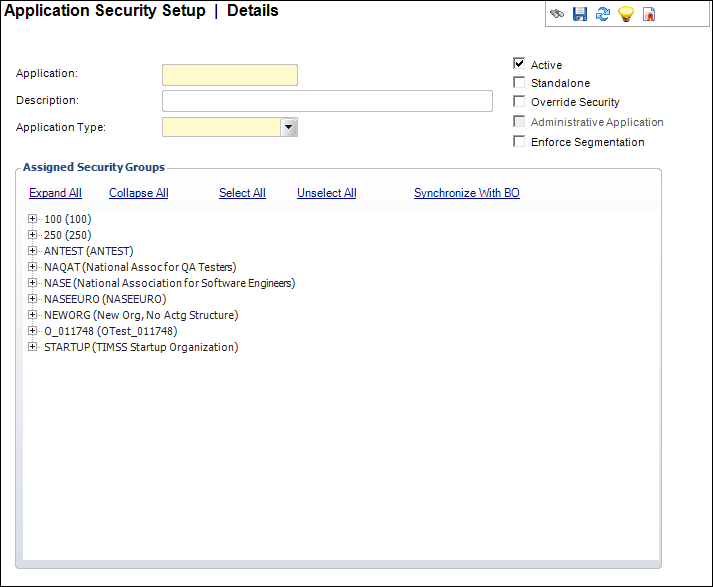 Screens
that are not published to
the database cannot be added to security groups or menus.
Screens
that are not published to
the database cannot be added to security groups or menus.
This screen is used when you create a new screen or batch job and you want to grant users access to the application. From the Application Security Setup screen, you can assign permissions to multiple security groups. Security groups must exist before you can assign permissions to them here.
 Screens
that are not published to
the database cannot be added to security groups or menus.
Screens
that are not published to
the database cannot be added to security groups or menus.
To define applications:
1. From the Security Central screen, click Maintain Application Security.
2. Click
Create New Application.
The Application Security Setup screen displays, as shown below.

3. Enter the Application name.
 Best
practice for entering the application is to start the application with
the three-letter acronym of the subsystem. For example, CUS for Customer
or MTG for Meetings.
Best
practice for entering the application is to start the application with
the three-letter acronym of the subsystem. For example, CUS for Customer
or MTG for Meetings.
4. Enter a Description for the application.
5. Select
the Application Type from the
drop-down.
The security groups display in the Assigned Security Groups section.
6. If you selected "XML Based Screen", select whether or not the screen will be Available for Advance Search.
7. Check the appropriate checkboxes:
a. Active
b. Standalone
c. Override Security
d. Enforce Segmentation
8. Click
the + next to the appropriate
security group to expand it. Double-click the permission code to grant
access for this application to this security group.
The red X changes to a green checkmark.
9. Click Save.
Screen Element |
Description |
|---|---|
Application |
Text box. A unique code for the application. Refer to the note in step 3 above for more information on best practice for how to label the application code. |
Description |
Text box. A description of the application. |
Application Type |
Drop-down. The type of application. For example, screen or batch process. Depending on which type is selected, different permissions display in the Permissions table. If you select "XML Based Screen", the Available for Advance Search checkbox displays. |
Available for Advance Search |
Checkbox. When checked, the Search Settings button will display for users to modify the search settings on that screen. Only displays when "XML Based Screen" is selected as the Application Type. |
Active |
Checkbox. When checked, indicates the application is active. This option is available so you can deactivate an application instead of deleting it. When unchecked, indicates the application is inactive and you cannot launch the screen. |
Standalone |
Checkbox. When checked, the application can stand alone and is not dependent on another screen. Standalone applications display in the list of screens (click the Screen link) on the Persona Menu Designer screen. Non-standalone screens, such as pop-ups or choosers, cannot be accessed through the command line. |
Override Security |
Checkbox. When checked, indicates any user can access the application, despite the user’s permissions. When unchecked, the permissions for viewing or editing remain for the application. Some screens, such as Choosers or some modal screens, do not require security, so checking this checkbox would not enforce security on those screens. |
Administrative Application |
Read-only checkbox. When checked, indicates the user performs administrator tasks and should have administrator rights. The properties of an administrator include being a super user, has access to Application Designer and Database Designer, can publish screens, can use debug tools, and has permission to admin screens and access points. |
Enforce Segmentation |
Checkbox. When checked, indicates this screen will enforce the segmentation rules. |